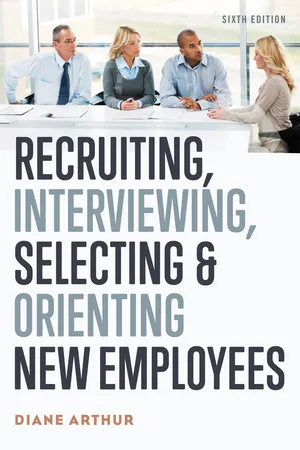1
RECRUITMENT FORECAST
Forecasts of any sort can be tricky, and this is no less true when it comes to predicting recruitment trends. There are countless factors that challenge an organization’s hiring efforts, many of which are outside our control, such as economic instability; political initiatives; mergers and acquisitions; decisions by senior management; budgetary restraints; and initiatives by competitors. So what can employers do to ensure that their hiring efforts result in the best possible workforce? Actually, more than you might think. It starts with an awareness of what was, as well as what is: that is, comparing what has worked in the past with current and evolving recommended initiatives; exploring the ramifications of hiring in today’s gig economy; assessing the upside of predictive analytics for data-driven recruitment; creating a profile for success unique to a particular work environment; exploring ways to minimize recruitment costs; and creatively competing for talent.
What’s New Is Old and Vice Versa
The objective of recruitment has historically been and will continue to be finding the best person for the job. This doesn’t always mean the most qualified (more on this later), but it does come down to striving to find the best “fit.” That fit refers not only to fitness for the job, but to fit within the organization’s culture, as well.
To achieve this objective, begin recruitment initiatives with a carefully thought-out and executed balancing act between what you have done in the past with what you may have read or heard about, or perhaps what your competition is doing. Ask yourself whether established policies and practices will help or hinder your hiring efforts. For example, adhering to traditional recruitment sources and methods may result in reaching a limited talent pool; however, relying exclusively on high-tech resources could exclude demographic groups that do not readily embrace technology.
The factors to consider as you evaluate how to best approach recruitment are not new; what may be different, however, is how you view or utilize them. Here are some questions to ask yourself as you evaluate the effectiveness of your approach to recruitment and strive to strike a balance between implementing what’s new and maintaining a “we’ve always done it this way” approach.
What Impact Will the Current Unemployment Rate Have on Our Recruitment Efforts?
This is a good place to start. Interpreting and reacting to unemployment numbers and trends can be dizzying, leaving organizations to question the wisdom of their thinking and wondering what they may need to do in response to the most recent unemployment report. Some opt to stand pat and not change anything when it comes to recruitment; others evaluate what their competitors are doing and follow suit; and some conduct complex cost analyses as they consider the pros and cons of hiring versus leaving vacated positions open.
Another way of putting this is, what effect does supply and demand have on your recruitment efforts? Generally, a rule of thumb when considering unemployment numbers is to remind oneself of who’s got the current advantage: employers or applicants. Higher unemployment rates increase the number of applicants in relation to the number of job openings. That puts employers in the so-called driver’s seat, allowing them to be highly selective and more conservative in their salary and benefits offerings. Lower rates of unemployment put employers in a less desirable position as they often struggle to fill jobs. Qualified individuals are in the enviable position of negotiating a hiring package that could exceed budgeted amounts.
This awareness helps employers establish a proactive way of thinking as they stay ahead of the numbers and draw conclusions from past trends while at the same time anticipating recruitment needs. While not foolproof, this approach can prevent you from being caught off guard and left scrambling, trying to figure out what to do when the economic roller coaster ride changes direction.
Do I Need to Fill This Job?
One way to protect yourself during times of economic turmoil is to ask yourself if you need to fill an opening. Just because there’s money in the budget to fill a job doesn’t mean you should. Let’s say Aaron, a longtime employee in Payroll, decides to retire. He’s performed his job well over the years, and has contributed to the efficiency of the department. The position is therefore approved to be filled, the assumption being that it’s necessary. But just because a task needs to be performed does not mean a particular employee should be the one to perform it.
Before proceeding with a replacement, ask yourself some key questions: How will filling this job help meet departmental and organizational goals? Are the tasks performed essential? If so, are these tasks that could be distributed among other employees without creating an undue hardship? Is a full-time replacement necessary when someone working part-time might be sufficient? Should we consider hiring a contingent or gig worker, on an as-needed basis? Could the job be outsourced?
That last question concerns control of an internal job function being turned over to an outside enterprise and will likely have the greatest impact on a department in a number of possible ways, including finding the appropriate business to perform the work, transferring information efficiently and with discretion, and assuring other employees that their jobs are not slated for elimination. The greatest upside of outsourcing is likely to be payroll and overhead cost savings. It may also allow an organization to better focus on core business initiatives, thereby increasing efficiency; providing faster and better services; and saving on infrastructure and technology. There may also be time zone advantages.
How Much Does Recruitment Cost?
The Society for Human Resource Management (SHRM) has reported that the average cost-per-hire (CPH) is $4,129.1 In reality, this can cost considerably more or less, depend...
